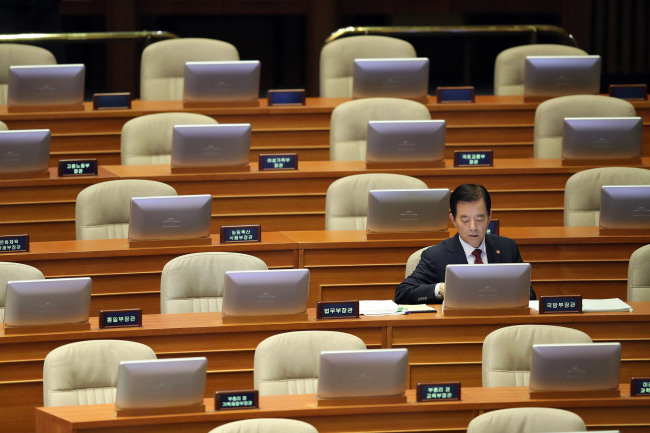North Korea said Wednesday that Tuesday’s launch of three missiles was aimed at boosting its capabilities to strike South Korean ports and airfields, in an apparent bid to ratchet up its protest against the Seoul-Washington plan to dispatch advanced U.S. antimissile assets here.
The firing of one Rodong and two Scud missiles was seen as a show of force targeting the allies’ recent announcement of their deployment decision. Seongju, North Gyeongsang Province, was picked as the location for the Terminal High Altitude Area Defense system.
The projectiles flew around 500 to 600 kilometers, placing within its reach the southern part of the peninsula including Seongju and the southeastern port city of Busan, Seoul’s Joint Chiefs of Staff said. The lineal distance between the launch site of Hwangju, North Hwanghae Province, and Seongju is about 380 kilometers.
“The drill was conducted by limiting the firing range under the simulated conditions of making preemptive strikes at ports and airfields in the operational theater in South Korea, where the U.S. imperialists’ nuclear war hardware is to be hurled,” the official Korean Central News Agency said.
During the event, the North “examined the operational features of the detonating devices for nuclear warheads mounted on ballistic rockets at the designated altitude over the target area.”
In images carried by Rodong Sinmun, the ruling Workers’ Party’s mouthpiece, North Korean leader Kim Jong-un observed the liftoff. On a table beside him was a map of the peninsula titled “the strategic forces’ firepower strike plan,” with a trajectory chart from Hwangju to such areas as Busan and another port city of Ulsan toward the East Sea.
Kim lauded the strategic forces as “thoroughly prepared for any sudden order and accurate and elaborate in terms of mobility and hitting power,” the Korean Central Television reported.
The Panmunjom Mission of the North’s Korean People’s Army also threatened that U.S. military bases in South Korea would be the first target of any attack, followed by South Korean troops.
“In case the U.S. imperialists transfer OPCON (wartime operational control) to the puppet forces, they will lose not only the pretext for staying in South Korea but also the excuse for interfering in Korean issues,” a KPA spokesperson was quoted as saying.
The JCS, for its part, convened an emergency video conference with commanders later in the day to review military readiness and the overall security situation.
It slammed Monday’s event and Pyongyang’s ensuing threats of preemptive attacks as a “clear ambition for a provocation beyond the previous missile tests.”
“We also discussed retaliation readiness assessing that there is a high possibility for a tactical surprise provocation not only near the land and maritime borders but also including a rear-area terror,” the JCS said in a statement.
 |
Defense Minister Han Min-koo prepares ahead of the parliamentary session on THAAD on Wednesday. (Yonhap) |
Meanwhile at the National Assembly, the debate over the THAAD issue continued on the second and final day of questioning, with top government officials and ruling Saenuri Party lawmakers defending the deployment plan while opposition lawmakers warned of its domestic and diplomatic impact.
On Tuesday, Seongju residents and lawmakers from the region expressed concerns that the North’s latest missile launch implied potential threats to the southeastern county due to the decision.
But Defense Minister Han Min-koo dismissed these worries, saying the test appeared to be intended as a “protest-like provocation aimed at the ongoing internal debate over the issue.”
By Shin Hyon-hee (
heeshin@heraldcorp.com)




![[Today’s K-pop] Blackpink’s Jennie, Lisa invited to Coachella as solo acts](http://res.heraldm.com/phpwas/restmb_idxmake.php?idx=644&simg=/content/image/2024/11/21/20241121050099_0.jpg)



